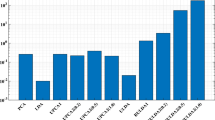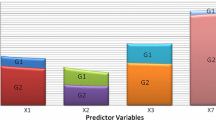Abstract
This paper extends the criterion of the misclassification ratio of discriminant model and presents a new selection method of discriminant model. For selecting the discriminant model, this method establishes the rule of misclassification degree ratio through misclassification ratio of the discriminant model and misclassification degree of the samples. To test the effect of this method, this work uses seven UCI data sets. Numerical experiments on these examples indicate that this method has certain rationality and has a better effect to select a discriminant model.
Similar content being viewed by others
References
R A Fisher. The use of multiple measurements in taxonomic problems, Annals of Human Genetics, 1936, 7(2): 179–188.
S Shinmura. New theory of discriminant analysis, In: new theory of discriminant analysis after R Fisher, Springer, Singapore, 2016.
F L Song, P Lai, B H Shen, G S Cheng. Variance ratio screening for ultrahigh dimensional discriminant analysis, Communications in Statistics Theory and Methods, 2018, 47(24): 6034–6051.
Y F Li, J Lei. Sparse subspace linear discriminant analysis, Statistics, 2018, 52(4): 782–800.
A Hidaka, K Watanabe, T Kurita. Sparse discriminant analysis based on estimation of posterior probabilities, Journal of Applied Statistics, 2019, 46(15): 2761–2785.
S C Chen, D H Li. Modified linear discriminant analysis, Pattern Recognition, 2005, 38(3): 441–443.
A B Ji, H J Qiu, M H Ha. Fisher discriminant analysis based on choquet integral, Applied Mathematics-A Journal of Chinese Universities, 2009, 24(3): 348–352.(in Chinese)
L W Huang, L T Su. Hierarchical discriminant analysis and Its application, Communications in Statistics - Theory and Methods, 2013, 42(11): 1951–1957.
X Z Xu, C W Huang, Y Jin, C Wu, L Zhao. Speech emotion recognition using semi-supervised discriminant analysis, Journal of Southeast University (English Edition), 2014, 30(1): 7–12.(in Chinese)
L W Huang. Modified Hybrid Discriminant Analysis Methods and Their Applications in Machine Learning, Discrete Dynamics in Nature and Society, 2020, DOI: https://doi.org/10.1155/2020/1512391.
E K Tang, P N Suganthan, X Yao, A K Qin. Linear dimensionality reduction using relevance weighted LDA, Pattern Recognition, 2005, 38(4): 485–493.
W H Yang, D Q Dai, H Yan. Feature extraction and uncorrelated discriminant analysis for high-dimensional data, IEEE Transactions on Knowledge and Data Engineering, 2008, 20(5): 601–614.
Q Zhang, H S Wang. On BIC’s selection consistency for discriminant analysis, Statistica Sinica, 2011, 21(2): 731–740.
J Pacheco, S Casado, S Porras. Exact methods for variable selection in principal component analysis: Guide functions and pre-selection, Computational Statistics and Data Analysis, 2013, 57(1): 95–111.
R A Mcdonald. The mean subjective utility score, a novel metric for cost-sensitive classifier evaluation, Pattern Recognition Letters, 2006, 27(13): 1472–1477.
S R Pan, J Wu, XQ Zhu. CogBoost: boosting for fast cost-sensitive graph classification, IEEE Transactions on Knowledge and Data Engineering, 2015, 27(11): 2933–2946.
A C Bahnsen, D Aouada, B Ottersten. Ensemble of example-dependent cost-sensitive decision trees, Expert Systems with Applications, 2015, 42(19): 6609–6619.
P Cao, D Zhao, O Zaiane. An optimized cost-sensitive SVM for imbalanced data learning, In: Advances in Knowledge Discovery and Data Mining, Lecture Notes in Computer Science, 2013, 7819: 280–292.
L W Huang. A selection method of discriminant model, Journal of Jiangxi University of Science and Technology, 2013, 34(1): 96–99. (in Chinese)
D Dua, E Karra Taniskidou. UCI machine learning repository, Irvine, CA: university of california, school of information and computer science, http://archive.ics.uci.edu/ml.
Author information
Authors and Affiliations
Corresponding author
Additional information
Conflict of interest
The authors declare no conflict of interest.
Supported by the National Natural Science Foundation of China(52070119) and Key Laboratory of Financial Mathematics of Fujian Province University (Putian University) (JR201801).
Rights and permissions
About this article
Cite this article
Huang, Lw. Misclassification analysis of discriminant model. Appl. Math. J. Chin. Univ. 38, 180–191 (2023). https://doi.org/10.1007/s11766-023-3823-8
Received:
Revised:
Published:
Issue Date:
DOI: https://doi.org/10.1007/s11766-023-3823-8




